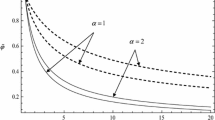Abstract
A physically correct and mathematically rigorous solution of the problem on the structure of an electromagnetic field formed when a shock wave enters a conducting half–space in a transverse magnetic field is obtained. It is shown that only physically grounded boundary conditions lead to a noncontrovercial pattern of the electromagnetic field and a system of currents in a conductor. The main parameters and characteristic times are found, which determine the structure of current waves in a metal. The solution in the uncompressed region is determined by the parameter R1 = µ0σ1D2t and that in the compressed region by the parameter R2 = µ0σ2(D—U)2t (σ1 and σ2 are the electric conductivities of the uncompressed and compressed substance, respectively, µ0 is the magnetic permeability of vacuum, D is the wave–front velocity, U is the mass velocity, and t is the time). The parameter for the compressed substance R 2 coincides with the parameter obtained previously for the shock–wave dielectric—metal transition; the governing parameter for the uncompressed substance R 1 is obtained for the first time. The asymptotic solutions of the problem for small and large times and the special case R 1 = R 2 considered help in understanding the physical meaning of the solution found.
Similar content being viewed by others
REFERENCES
H. Knoepfel, Pulsed High Magnetic Fields, North-Holland, Amsterdam (1970).
L. V. Al'tshuler, “Application of shock waves in highpressure physics,” Usp. Fiz. Nauk, 85, No. 2, 197–258 (1965).
P. Caldirola and H. Knoepfel (eds.), Physics of High Energy Density, Academic Press, New York (1971).
J. M. Burgers, “Penetration of a shock wave into a magnetic field,” in: R. K. M. Landshoff (ed.), Magnetohydrodynamics (Symp. Proc.), Stanford Univ. Press, Stanford (1957).
E. I. Zababakhin and M. N. Nechaev, “Shock waves of the field and their cumulation,” Zh. Éksp. Teor. Fiz., 33, No. 2 (8), 442–450 (1957).
S. I. Pai, Magnetogasdynamics and Plasma Physics, Springer-Verlag, Wien (1962).
Yu. V. Makarov and É. K. Chekalin, Physical Processes in Electromagnetic Shock Tubes [in Russian], Atomizdat, Moscow (1968).
D. A. But, “Penetration of a shock wave with a conductivity jump into a transverse magnetic field,” Magn. Gidrodin., No. 4, 3–10 (1970).
J. N. Fritz and J. A. Morgan, “An electromagnetic technique for measuring material velocity,” Rev. Sci. Instrum., 44, No. 2, 215–221 (1973).
Yu. N. Zhugin and K. K. Krupnikov, “Induction method of continuous recording of the velocity of a condensed medium in shock-wave processes,” Prikl. Mekh. Tekh. Fiz., No. 1, 102–108 (1983).
S. D. Gilev and T. Yu. Mikhailova, “Current wave in shock compression of a substance in a magnetic field,” Zh. Tekh. Fiz., 66, No. 5, 1–9 (1996).
S. D. Gilev and T. Yu. Mikhailova, “Electromagnetic processes in a system of conductors formed by a shock wave,” Zh. Tekh. Fiz., 66, No. 10, 109–117 (1996).
S. D. Gilev, “Shock-induced conductivity waves in metallic samples,” Fiz. Goreniya Vzryva, 31, No. 4, 109–116 (1995).
S. D. Gilev, “Shock-induced conductivity waves in a conductor placed in an external magnetic field,” Fiz. Goreniya Vzryva, 32, No. 6, 116–122 (1996).
E. I. Bichenkov, “Electromagnetic field and current waves generated by a shock wave entering a conductor with a transverse magnetic field,” Prikl. Mekh. Tekh. Fiz., 38, No. 2, 19–25 (1997).
B. M. Budak, A. A. Samarskii, and A. N. Tikhonov, Collection of Problems in Mathematical Physics [in Russian], Nauka, Moscow (1972).
I. E. Tamm, Fundamentals of the Theory of Electricity [in Russian], Nauka, Moscow (1989).
A. N. Tikhonov and A. A. Samarskii, Equations of Mathematical Physics [in Russian], Nauka, Moscow (1977).
É. M. Kartashov, Analytical Methods in the Theory of Thermal Conductivity of Solids [in Russian], Vysshaya Shkola, Moscow (1985).
B. Ya. Lyubov, “Solution of an unsteady onedimensional problem of thermal conductivity for a region with a uniformly moving boundary,” Dokl. Akad. Nauk SSSR, 57, No. 6, 551–554 (1947).
É. M. Kartashov and G. M. Bartenev, “Method of integral equations in the analytical theory of thermal conductivity in constructing Green's functions for generic boundary-value problems,” Izv. Vyssh. Uchebn. Zaved., Fiz., No. 3 (82), 20–27 (1969).
Author information
Authors and Affiliations
Rights and permissions
About this article
Cite this article
Gilev, S.D., Mikhailova, T.Y. Electromagnetic Field and Current Waves in a Conductor Compressed by a Shock Wave in a Magnetic Field. Combustion, Explosion, and Shock Waves 36, 816–825 (2000). https://doi.org/10.1023/A:1002871126669
Issue Date:
DOI: https://doi.org/10.1023/A:1002871126669



